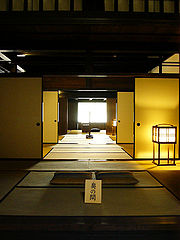
Fusuma
Encyclopedia

Japanese architecture
' originated in prehistoric times with simple pit-houses and stores that were adapted to a hunter-gatherer population. Influence from Han Dynasty China via Korea saw the introduction of more complex grain stores and ceremonial burial chambers....
, fusuma (襖) are vertical rectangular panels which can slide from side to side to redefine spaces within a room, or act as doors. They typically measure about 90 centimetres (3 ft) wide by 180 centimetres (5.9 ft) tall, the same size as a tatami
Tatami
A is a type of mat used as a flooring material in traditional Japanese-style rooms. Traditionally made of rice straw to form the core , with a covering of woven soft rush straw, tatami are made in standard sizes, with the length exactly twice the width...
mat, and are two or three centimeters thick. The heights of fusuma have increased in recent years due to an increase in average height of the Japanese population, and a 190 cm height is now common. In older constructions, they are as little as 170 cm high. They consist of a lattice
Latticework
Latticework is a framework consisting of a criss-crossed pattern of strips of building material, typically wood or metal. The design is created by crossing the strips to form a network...
-like wooden understructure covered in cardboard and a layer of paper or cloth on both sides. They typically have a black lacquer
Lacquer
In a general sense, lacquer is a somewhat imprecise term for a clear or coloured varnish that dries by solvent evaporation and often a curing process as well that produces a hard, durable finish, in any sheen level from ultra matte to high gloss and that can be further polished as required...
border and a round finger catch.
Historically, fusuma were painted, often with scenes from nature such as mountains, forests or animals. Today, many feature plain rice paper, or have industrially printed graphics of fans, autumn leaves
Autumn leaf color
Autumn leaf color is a phenomenon that affects the normally green leaves of many deciduous trees and shrubs by which they take on, during a few weeks in the autumn season, one or many colors that range from red to yellow...
, cherry blossom, trees, or geometric graphics. Patterns for children featuring popular characters can also be purchased.
Both fusuma and shōji
Shoji
In traditional Japanese architecture, a shōji is a door, window or room divider consisting of translucent paper over a frame of wood which holds together a lattice of wood or bamboo...
(sheer, translucent paper room dividers
Room Dividers
Room dividers are used by interior designers and architects as means to divide space into separate distinct areas.There are a number of different types of room dividers such as cubicle partitions, pipe and drape screens, shoji screens, and walls. Plants, shelves or railings might also be used as...
) run on wooden rails at the top and bottom. The upper rail is called a , literally "duck's place", and the lower is called a . Traditionally these were waxed, but nowadays they usually have a vinyl lubricating strip to ease movement of the fusuma and shōji.
Along with the fusuma, shōji and tatami straw mats (as the floor) make up a typical Japanese room
Washitsu
, meaning "Japanese-style room", is a Japanese term used as an antonym for the term yōshitsu , meaning "Western-style room." Another term for washitsu is nihonma , and the comparative other term for yōshitsu is yōma ....
.

